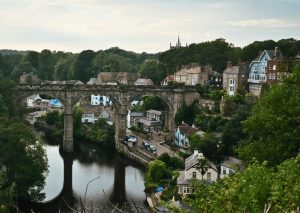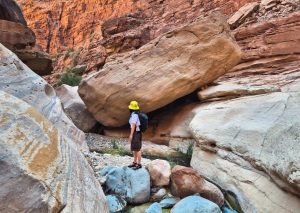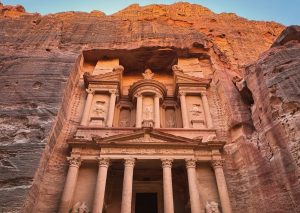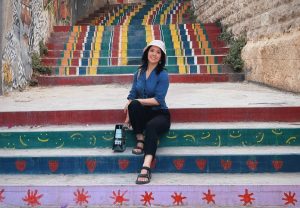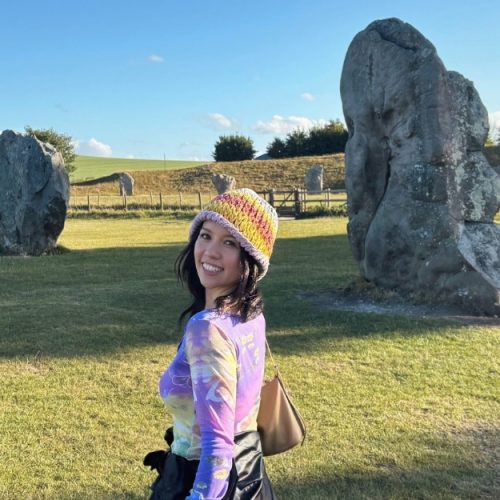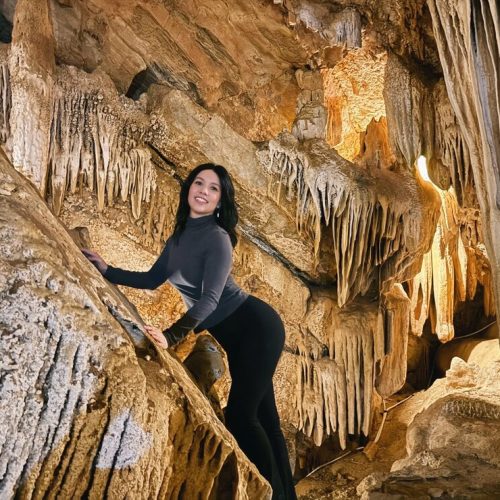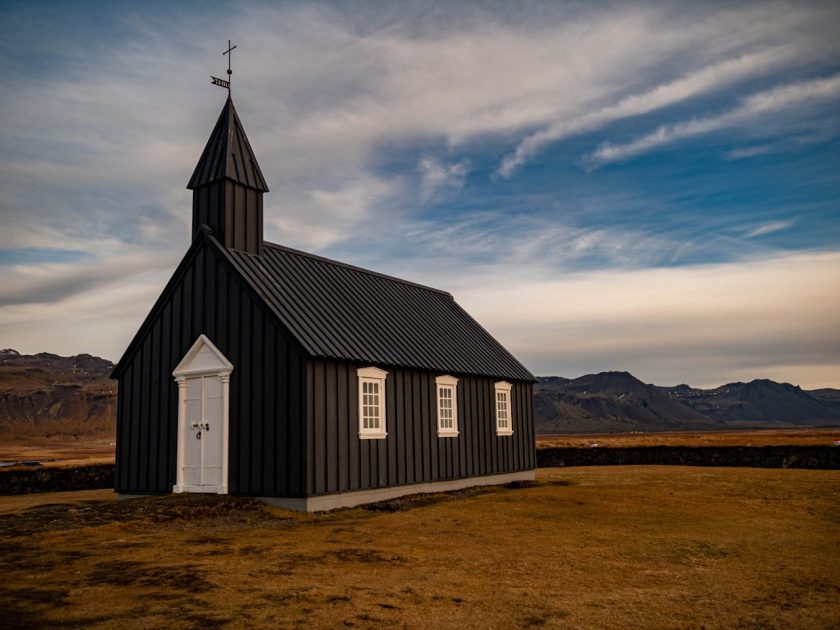
Nicknamed ‘Iceland in Miniature’, Snæfellsnes peninsula is one of my favourite areas in the whole of Iceland.
Jutting out 90 km into the Atlantic Ocean, this peninsula receives a battering from the elements, and as a result, the landscape is wild, atmospheric and varied.
The scenery is incredible and you get to experience it all in just a couple of hours from Reykjavik. This is great if you’re pushed for time and looking to see more beyond Reykjavik and the Golden Circle – the two most popular stops for those visiting Iceland in just a few days.
Getting there by car hire or group tours
Before I dive into what this area has to offer, I’ve got a few comments on logistics. If you are super strapped for time you could visit Snæfellsnes peninsula in a day but I would really recommend spending a night or two in order to fit everything in and enjoy this less visited area of Iceland.
Undoubtedly hiring a car is the easiest and most efficient way to ensure you visit all the key places at the pace you want. You can compare prices and book car hire via Rentalcars.com.
However, if you don’t drive, or you’re not a fan of hiring a car abroad, then you still have the opportunity to join a small-group tour of the Snæfellsnes peninsula from Reykjavik.
The best things to see on the Snæfellsnes peninsula
Recently, Snæfellsnes peninsula featured in the Hollywood movie The Secret Life of Walter Mitty with Ben Stiller. So if you’re heading to Iceland, I really recommend watching the film beforehand to get you all excited before your trip.
Kirkjufell

I read somewhere that the most photographed attraction of Snæfellsnes is Kirkjufell, the symmetrical mountain also known as The Lonely Mountain. It rises 463m above the shoreline into an almost perfect peak. This striking mountain and waterfall combination means it’s a highly coveted spot for photographers and instagammers trying to capture Iceland’s unique landscape.
If I’m honest, it’s not one of my favourite Icelandic waterfalls, but this is only because Iceland has so many incredible waterfalls – it’s still beautiful though!
If you’re feeling adventurous, it’s possible to climb the mountain but this is reserved only for experienced hikers since the incline is very steep and exposed. Alternatively, there are some nice walking routes in the area that offer gorgeous views and varied birdlife. Also nearby is the beautiful waterfall, Kirkjufellsfoss.
Stykkishólmur

Stykkishólmur is the largest town on Snæfellsnes peninsula. The funny thing is, with approximately 1100 people it’s not even a large town – it’s small – but this gives you an idea of how remote this peninsula can feel.
The town is picturesque but a few large box-shaped buildings give it an industrial feel as well. All in all, the brightly coloured buildings from the late 19th century that have been built around a natural harbour add a lot of charm.
This fishing town is located on a promontory overlooking Breiðarfjörður, a really beautiful bay and is best seen from the bright orange lighthouse, located just a short hike from the Ferry Baldur loading area.

Where to eat: Afterwards, I suggest getting a bite to eat in one of the cafés or restaurants. If you’re looking for tasty low-key grub, Skipper Restaurant does great fish & Chips and burgers. For something more elevated, Sjávarpakkhúsið is the place to go. It was out of my budget, but if you’re looking to treat yourself to fancy seafood dishes, it’s considered the best in town.
From Stykkishólmur, you can also get a ferry over to Flatey, a unique and remote island that is part of a cluster of 40 or so smaller islands. The island is almost completely devoid of hills, hence the name Flatey meaning ‘flat island’.
Furthermore, the nature of Flatey is kept in pristine condition due to their no cars allowed policy. It’s small so you can walk around the whole island and enjoy the abundance of birdlife. Migratory birds such as puffins, arctic terns and more can be spotted depending on the time of year.
Djúpalónssandur

Djúpalónssandur is my favourite area on Snæfellsnes. I love it. It’s like something out of Jurassic Park.
You can walk between interesting lava formations including one with a large hole in the middle, giving you a perfect view to the Snæfellsjökull glacier.
There’s also a black beach, and if you look closely you’ll probably spot some rusty chunks of metal dotted across it. These are the remains of a British trawler called The Epine GY7 that crashed into the rocks in 1948. Sadly, 14 men lost their lives and some were never found.
You can read more about my trip to Djúpalónssandur here.
Bjarnarhöfn

There are two main attractions in this area: Bjarnarhöfn Shark Museum and Berserkjahraun lava field.
At the shark museum is one of those quirky little museums that can only exist in Iceland. Head inside and discover more about Icelandic seafarers and the Greenland shark which lurk deep in the nearby waters.
If you’re feeling brave enough, you can even try some Greenland shark washed down with a shot of Brennivin. It’s what the late, great, Antony Bourdain did when he visited. Curious, I also obliged during my visit, and let’s just say I won’t be doing it again! One thing is for sure, the Brennivin will warm up your throat, especially on a cold day!
Above Bjarnarhöfn lies Bjarnarhafnarfjall, a beautiful mountain that beckons both hikers and photographers. Also nearby is the rugged Berserkjahraun lava field, meaning ‘Berserk’s lava’. It has all kinds of strange shapes, with beautiful colours, and stark contrasts in the rock and mosses. The area is steeped in history, featuring prominently in Eyrbyggja saga and Heidarviga saga.
Arnarstapi
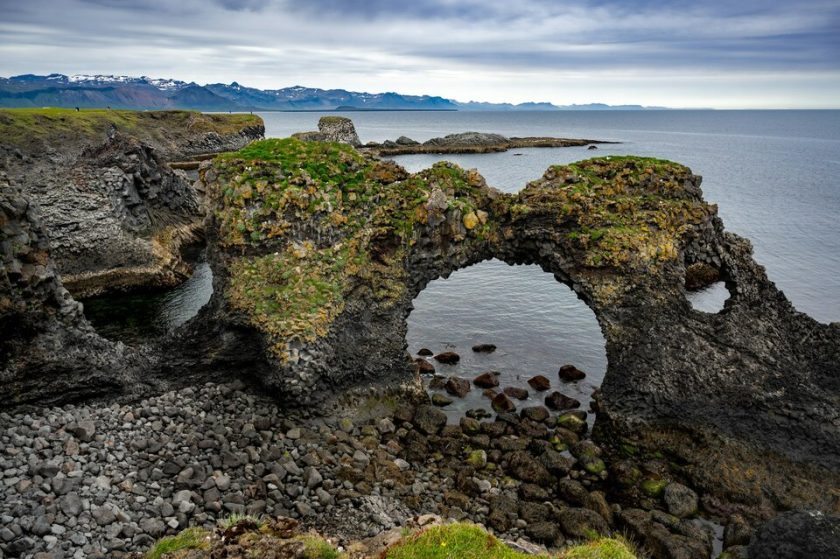
I love love Arnarstapi, like Djúpalónssandur, it’s wild, rugged and full of geological wonders. There’s a walking path that hugs the coast, past craggy sea arches and rock formations that feel mythic, like trolls caught mid-step. The kind of landscape where sagas were born and people still believe the land has rules of its own. There’s little crowds, just you and nature – just salt air, sharp light, and Mother Nature at your feet.
Gerðuberg

© Flickr.com/Dominik Felber
Gerðuberg is long cliff of hundreds of basalt columns standing like an army of pillars. When you arrive, take the path that leads below the columns for the best view of these stunning geological formations. They are mostly twelve to fourteen metres high and about one and a half meters in diameter. Some are even leaning forward giving the cliff a spectacular view as you pass by.
However, if you’re particularly interested in basalt columns, it doesn’t stop at Gerðuberg – it’s only the start. For the best examples of these unique formations in Iceland, read: Geology Rock! Basalt Columns in Iceland.
Snæfellsjökull Glacier

Snæfellsjökull is a snow-capped glacier that covers a volcano. At its highest point, the summit rises to 1,446 m and through activity companies you can reach it by hiking, Super Jeep or Snow Cat.
This volcano has also been immortalised by Jules Verne’s novel A Journey to the Centre of the Earth (1864). Snæfellsjökull is where the protagonists find the entrance to a passage leading to the centre of the earth.
Where to stay on the Snæfellsnes peninsula
My favourite hotel on the peninsula is Hotel Búdir. It has views to die for overlooking the glacier, black church and lake. The interior is super charming with cosy communal areas as well as a library.
However, it all depends on your budget so it’s a good idea to compare other hotels in the area too.
Are you planning a trip to Iceland’s Snæfellsnes peninsula?



